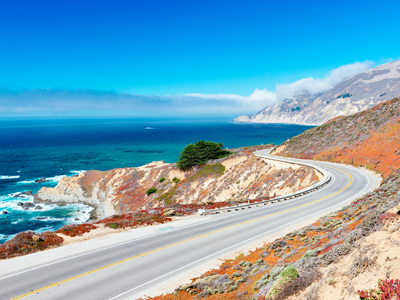
The Pacific Ring of Fire
This GCSE Geography quiz takes a look at the Pacific Ring of Fire. The GCSE syllabus requires that you know how volcanoes are formed, where in the world they are found and how the hazards they pose can be managed. With only a few exceptions, volcanoes are found in well-defined strips across the Earth. The Pacific Ring of Fire is a term that is used to describe one of these areas. It is a horseshoe shaped band of volcanoes that is found around the edges of the Pacific ocean. It stretches from near the tip of South America, northwards up the west coast, bends round through the Aleutian Islands, Japan, Indonesia, then out into the south Pacific and finally down to New Zealand.
Volcanoes are formed where molten magma forces its way through the Earth's crust to reach the surface. It is not just magma that comes out of a volcano, there is a lot of dust, ash, sometimes volcanic 'bombs' plus a lot of gases, some of which are toxic. The magma is called lava where it reaches the surface. This then solidifies over a long period of time, adding new (igneous) rocks to the crust.
The magma that forms some volcanoes is viscous (thick and sticky), but in others it can be quite runny. Eruptions from the volcanoes with a runny type of lava are usually less destructive than the ones with viscous lava. This is because volcanoes with viscous lava tend to be much more explosive. These explosions can cause massive destruction. You may have looked at the case study of Mt. St. Helens which erupted in the 1980s. It literally 'blew its top' and the mountain was several hundred metres lower after the eruption than it was before.
As well as the toxic gases, explosions, lateral blasts and flows of red-hot rock, there are other major hazards that come from volcanic eruptions. Some volcanoes are high enough to have snow at their summits all year round. During an eruption, this rapidly melts and mixes with soil and rocks to form deadly mudflows (lahars). Ash and red-hot gases can flow down the side of a volcano as a pyroclastic flow (also called a nuée ardente), scorching the ground and destroying everything living in its path. The only real way of managing these hazards is to learn how to predict when an eruption is going to happen and evacuate everyone from the danger area.
The Ring of Fire is not just about volcanoes. As the Pacific plate is forced back down into the mantle by the plates around it, major earthquakes also occur. These are hard to predict and can create large landslides like the one that buried the entire village of Yungay in Peru. Volcanologists can usually give several days warning that a volcano is about to erupt, however, earthquakes are more difficult. How both hazards are managed around the Pacific depends on whether the country is a MEDC or LEDC. There is likely to be greater loss of life in an LEDC as they are less well prepared, can spend less money on prediction and have poorer communications.
Ready for more?
not all...
quizzers. Try to win a coveted spot on our Hall of Fame Page.







